More about Thimbles





Magdalena and William Isbister.
Introduction
The definitive work on Children’s thimbles was written by Diane Pelham Burn and published in 1995 (1). It has since been reprinted. Children’s thimbles are compared with adult thimbles spanning the different periods of manufacture. Holmes wrote about Children’s thimbles but most of his work related to the Children’s thimble literature and there was really very little written about the thimbles themselves (2).
Burn defines a children’s thimble as having a maximum outside diameter of 1.25 cm, but since the thickness of thimbles vary considerably, and with small sizes, the wall thickness becomes increasingly important, we have chosen to measure the internal diameters of the thimbles and include in this paper only those thimbles with an inside diameter (ID) of 1.25 cm or less. Children’s fingers go inside the thimble and thus we argue that it is the internal diameter which is important in sizing a thimble. It was of interest to find that the French thimble making company, A Féau, clearly only used internal diameters as did Gabler Brothers in Germany.
We do not intend to repeat previous writings; we simply wish to document some further examples of interesting children’s thimbles.
Early thimbles
The earliest thimble is hand made of latten, is vertically dimpled and was found near Salisbury. It has an internal diameter (ID) of 1.1 cm. It probably dates to the 12th or 13th century.

Beehive thimbles from the 14th century were also made for little fingers, these two having IDs of 1.1 cm. and 1.2 cm. respectively.
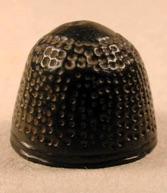

17th century
An early hand dimpled pewter topped brass thimble dates to the 17th century and has an ID of 1.2 cm. It is not known where it was made.
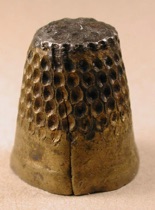
This 17th century brass thimble was made in Nürnberg. It was found near the old Post Station in the Müritz region of the Nahe in Mecklenburg. The border is decorated with a floral band. It has an ID of 1.25 cm.
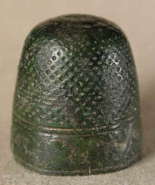
In the late 17th and early 18th century machine dimpling had been established in both Holland and England and many such thimbles have been found in children’ sizes. The Dutch Holmes type ll thimble (1690-1730) on the left has an ID of 1.2 cm. and the Lofting type thimble in the middle has a similar ID. The Holmes type lll thimble (1730-1800) on the right has an ID of 1.05 cm.
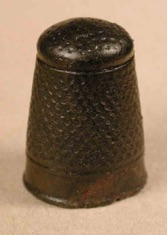
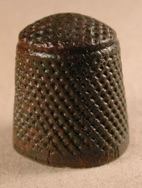
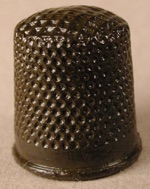
This early 17th century English silver thimble is made in two parts and has an unknown makers mark. The top seems to have been hand dimpled. It was found in the fields of Norfolk and has an ID of 1.0 cm.
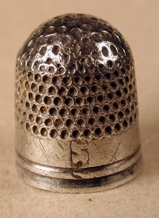
Later in the century many of the other familiar thimble types were made in child’s sizes. The thimble on the left has a double heart cartouche supported by Putties and is engraved ‘MN’ above a rope band. It is a two-part thimble and has an ID of 1.25 cm. The thimble in the middle, also a two part thimble, has a heart shaped cartouche supported by Putties engraved with the letters “C+D” and a plain flat rim. The ID is 1.25 cm. The thimble on the right, a two-part thimble too, has a plain band with a mounted turquoise cabochon above grooved bands. It has an ID of 1.1 cm. and is rather uncommon.

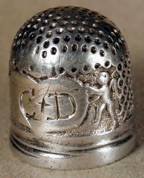
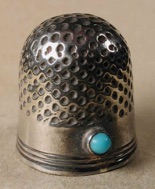
This rather crudely engraved silver thimble was probably made in England sometime towards the end of the 17th century. The plain flat rim is engraved with a floral design and it has an ID of 0.95 cm.
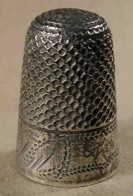
18th century
In the 18th century steel topped thimbles were introduced and these thimbles, too, were made in child’s sizes. The left thimble was made by an unknown maker and had the initials ‘HB’ engraved above grooved bands. It has an ID of 1.1 cm. The middle thimble similarly had a steel top but as is often the case in buried thimbles the steel has rusted away. The maker’s initials seem to be SI but the maker is unknown. The ID is 1.2 cm. The thimble on the right has an ID of 1.2 cm.
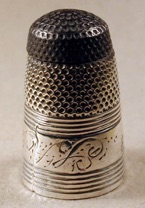
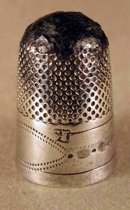
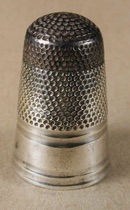
Steel topped brass thimbles were made in simple styles. This thimble has an ID of 1.15 cm.
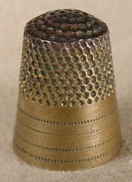
As the 18th century progressed silver thimbles became more decorative and taller, and were made by ‘deep drawing’ so that they were made in one piece. Both of these thimbles have floral decorations on the border. The left thimble is still a two-part thimble and has an ID of 1.2 cm. The right thimble was made in one piece and has an empty cartouche and an ID of 1.05 cm.
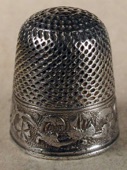
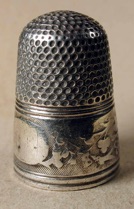
19th century
By 1800 thimble making was becoming well established, rims were often ‘turned over’ and thimbles were made in a greater variety of styles and patterns. The left thimble has a round turnover rim and an ID of 1.1 cm. The middle ‘keepsake’ thimble has ‘REGARD’ milled on to the border and a decorated turnover rim. The ID is 1.25 cm. The right thimble is ‘French’, has a simple everted rim and an ID of 1.2 cm.
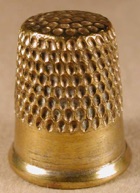
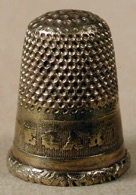
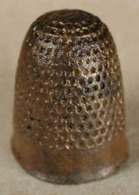
This gold trimmed ivory thimble was probably made in France and originally would have been part of a larger child’s sewing etui. It has survived undamaged and has an ID of 1.25 cm. The finger guard is simply ribbed and has an ID of 1.2 cm.
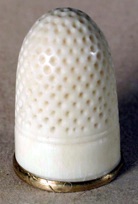
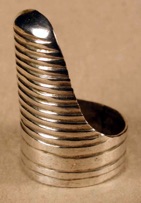
The first silver thimble has a plain round rim whereas the other thimbles have plain round or faceted turnover rims. All the thimbles are engraved with ‘wiggle work’ patterns. The internal diameters from left to right are 1.0 cm., 1.15 cm., 1.1 cm., and 1.1 cm. The last thimble was made by James Swann of Birmingham in 1896, the other three thimbles are unmarked.
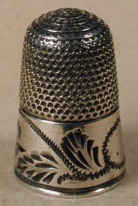


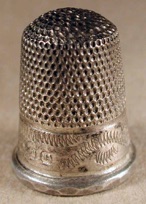
The left thimble has a flat turnover rim and was made by James Fenton of Birmingham in 1890 and has an ID of 0.95 cm. It is interesting that this tiny thimble is marked whereas only one of the above larger thimbles bears an hallmark. The right thimble is heavily embossed with four panels containing figures, two facing left and two facing right. This is a so-called Waciorski-Holmes Type ll thimble and was made by George Unite of Birmingham in 1894. It is engraved with ‘Sheila, Feb: 11, 1907’ on the plain flat rim. The ID is 1.1 cm. The thimble has its own red leather covered and silk lined fitting box.
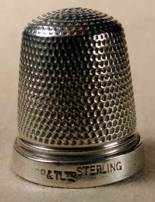
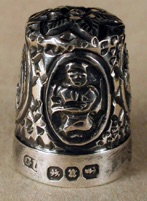
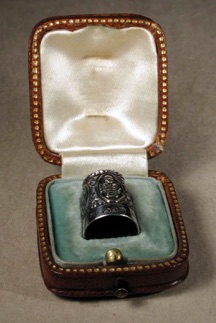
The so called ‘Train’ thimbles seem to have been made in the mid 19th century by several makers. They should more properly be called ‘Railway’ thimbles (3) because one such thimble came in a cardboard box with an engraving of the train on the lid which was inscribed ‘The Railway Thimble’. The thimbles are unmarked and have an early steam locomotive pulling a variety of coaches. The locomotives seem to be different and are difficult to identify. The left thimble has a round turnover rim and an ID of 1.15 cm. The locomotive may be Ericcson and Braithwaite’s locomotive ‘The Novelty’ which was built for the Rainhill Trials in 1829. The driver sits at the front and the stoker at the back. The middle thimble has a turnover faceted rim and the locomotive appears to have a tender. It could be a representation of George Stephenson's locomotive, the ‘Rocket’. It has an ID of 1.2 cm. The right thimble has a round turnover rim and possibly another representation of the ‘Novelty’. The train seems to be travelling over a viaduct of some sort. It has an ID of 1.25 cm.
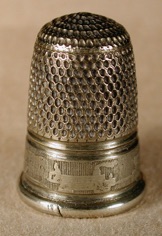
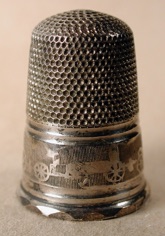
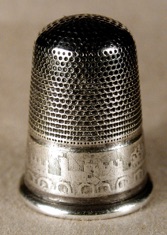
20th century
Children’s thimble making continued into the 20th century, designs became more complex but overall fewer thimbles were made as the century progressed. The left thimble is a simple utilitarian English thimble, probably made in the 30s and has an ID of 1.1 cm. The right, rather tall, thimble was made by the Settmacher Brothers in Austria, has a wavy flat rim and a decorated border between two grooved bands. The ID is 1.1 cm.
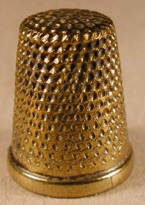
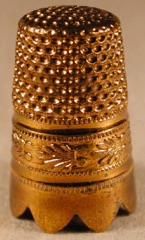
Perks, Pearce and Thompson, Ltd. of Birmingham made the simple child’s thimble on the left. It is marked PP&T Ltd. – STERLING and has an ID of 1.25 cm. It was probably made for export. The right thimble was hallmarked in Chester in 1907 and made by Henry Griffith and Sons Limited of Birmingham. It has a daisy band, a flat turnover rim and an ID of 1.25 cm.
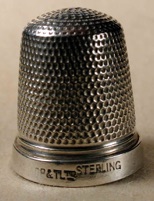
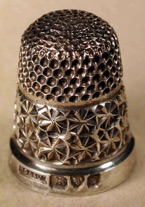
The next two thimbles are continental, the left thimble being made in Germany in about 1920. It has an applied shield shaped cartouche with the initials ‘GH’ engraved on it. The border is decorated with a ‘star band’ between ribbed bands above a rope band. The round turnover rim has an ID of 1.25 cm. The right thimble came with a fitted light blue silk covered box marked ‘Jul. Hügler. Juwelier vorm F. Czermak & Hügler. Wien. L. Freisingergasse 4’. Julius Hügler was a jeweller to the Imperial Austro-Hungarian Court. The thimble also has an applied shield shaped cartouche with the name ‘Sofie’. Instead of a ‘star band’ this thimble has a ‘diamond band’ with buttons. The thimble has a dog’s head Austrian mark (1886-1922) for 800 silver, a maker’s mark, ‘AH’, probably for Andreas Hart, a thimble maker in Vienna (1894-1912), and an ID of 1.0 cm.
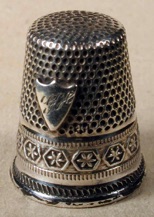
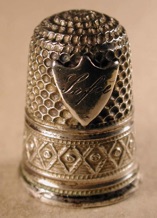
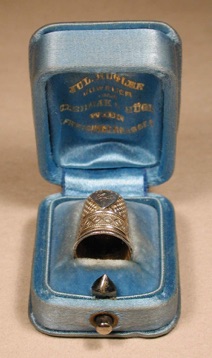
This thimble is included to illustrate the problems that may occur with thimble sizes. It a an American thimble, made by Ketcham and McDougall, Brooklyn, NY in about 1880, bears the KMcD mark in the top, has a plain border with the number ‘5’ size and a decorated turnover rim. The ID is 1.25 cm., and the outside diameter is 1.5 cm. American size ‘5’ is supposed to correspond to a ‘diameter’ of 13-13.5 mm. and thus bears no relation to the actual thimble sizes whether measured on the inside or the outside. It illustrates well the problems of using a number to designate a measurement which should be expected to be accurate if it is to be of any use to a prospective buyer trying to fit a thimble to a particular sized finger.
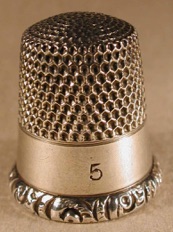
A child’s ‘child’s’ (i.e. a toy) thimble measures I cm. high and has an ID of 0.65 cm. It is simply dimpled and bears a James Fenton, Birmingham, 1909 hallmark. The dimples look rather large in comparison with the hallmark. It is included to show how small thimble makers were prepared to make thimbles at the turn of the last century.

Conclusions
In the 17th century many children had to sew to eek out the family income. As time passed the children of richer parents began to sew for pleasure. In modern times children do not have time to sew! Children’s thimbles have followed this social trend. Initially the thimbles were utilitarian and inexpensive, then they became more decorated and made of precious metals, and finally in the present time very few children’s thimbles are made or can be found. Their manufacture and styling follow, fairly closely, the social changes of the times.
References
1. Burn DP. Sew Small: Children’s Needlework Tools. Thimble Collectors International, 1995.
2. Holmes EF. A history of thimbles. London: Cornwall Books, 1985. pp. 167.
-
3. Aldridge E. Thoughts on thimbles. Thimble Collectors International, 1983. pp. 49.
Holmes: ‘Children’s Thimbles’ pp. 167.
Researched and published in 2002/11
Copyright@2011. All Rights Reserved
Magdalena and William Isbister, Moosbach, Germany
children’s thimbles
Navigation
